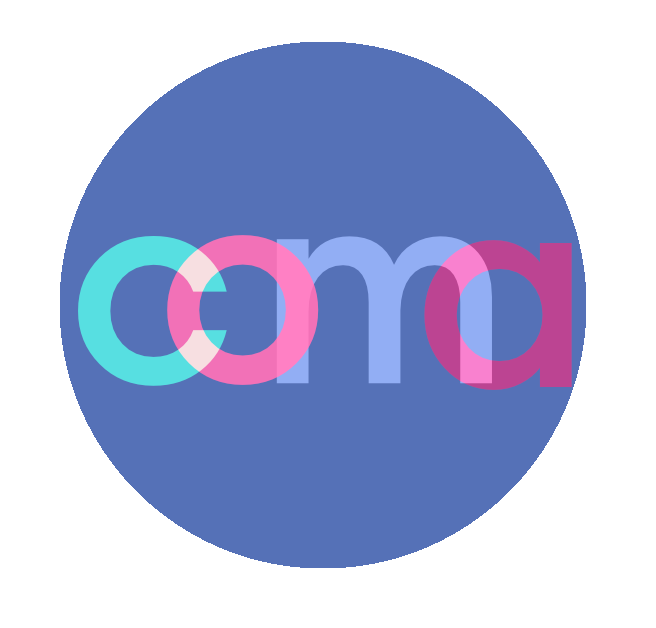GUO FENGYI: SHAMANIC VISUALIZATIONS OF THE SUBTLE BODY
A note on the exhibition Guo Fengyi: To See from a Distance
The Drawing Center, New York, February 20 - May 10, 2020
The visualization of subtle energies must be understood as a significant aspect of the range of mediumistic art. It is a direct and independent expression of spiritual experiences. Artists such as Georgiana Houghton (1814-1884), Emma Kunz (1892-1963), Jules Godi (1902-1986), or Henriette Zéphir (1920-2012) have each found their own autonomous visual vocabulary for the manifestation of invisible energetic influences, which surround and penetrate the world and human beings, and which are the basis of physical-psychical interaction. Victor Hennequin (1816-1854), arguably the first mediumistic artist, left us drawings of actually invisible energy patterns. [1]
In the ancient Chinese traditional view, life energy qi flows through the entire cosmos and everything in it. The art of perceiving, directing and using this energy in one's own body and for the benefit of others is taught in qigong. The Taoist world view knows three levels of being: the material level, the spiritual level, and an intermediate level that forms a bridge between the material and the spiritual. On this level, qi exists as a mediating subtle energy carrier between the tangible and the invisible. Since the Han Dynasty (206 BCE – 220 CE) qigong has been considered one of the four major branches of medicine in China. The roots of qigong are mental and physical exercises that go back to Taoist and Buddhist practice. Qigong means “work or exercise with qi”. The rediscovery of qigong in China at the beginning of the 1980s went through several phases. In the course of this development many new schools and styles of qigong emerged. [2]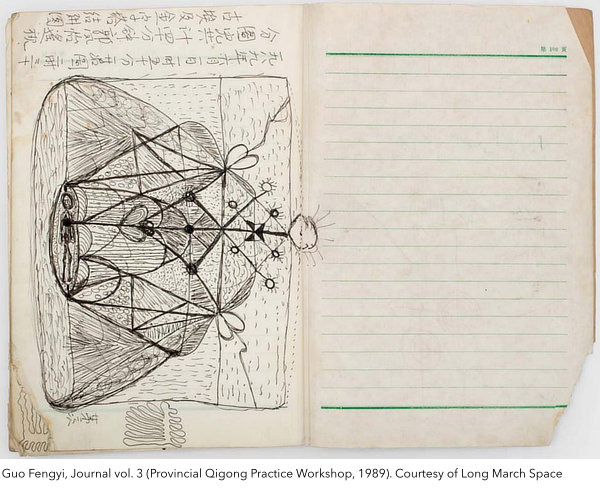 Guo Fengyi (1942-2010) was born in Xi'an, China. She worked as a technician in a factory for rubber and solvents. At the age of 39 she fell ill with acute arthritis and had to give up her job. In search of self-healing for her suffering, she immersed herself deeply in the practice of qigong and cept records of her experiences with subtle energies in notebooks. In addition to the written notes about the interaction of body, soul and qi, she created numerous very individual sketches of energy pathways, subtle vortices, emerging and dissolving forms, up to the representation of the complex interplay of subtle energetic processes in the anatomical system.
Guo Fengyi (1942-2010) was born in Xi'an, China. She worked as a technician in a factory for rubber and solvents. At the age of 39 she fell ill with acute arthritis and had to give up her job. In search of self-healing for her suffering, she immersed herself deeply in the practice of qigong and cept records of her experiences with subtle energies in notebooks. In addition to the written notes about the interaction of body, soul and qi, she created numerous very individual sketches of energy pathways, subtle vortices, emerging and dissolving forms, up to the representation of the complex interplay of subtle energetic processes in the anatomical system.
In her early works, a searching hand reveals itself, which in quickly executed, short strokes probes the right path. But soon Guo finds stability and decisive dynamics in her artistic expression. She begins to draw on the reverse of old calendars, which she sometimes glues together to create a larger drawing surface.
Not only her occupation with qi, but especially the creative process, through which she confidently expresses this occupation, becomes her very own technique of self-healing. Soon Guo, who had no academic art training, found that the visual worlds which she created, charged with a large variety of symbolic references, seemed much better suited to give adequate expression to her inner experiences than her written records. Thus, she shifted to creating peculiar iridescent paintings on ever larger sheets of paper, even on scrolls of paper up to several meters in length.
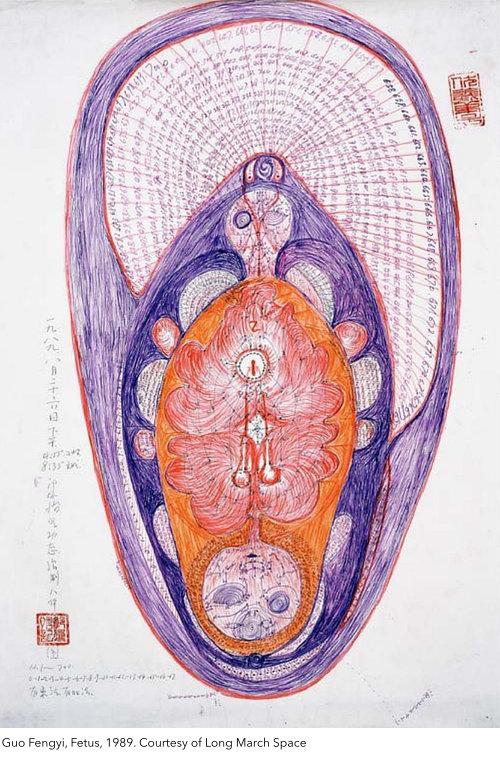 The human body is at the center of Guo Fengyi’s work. But it is a human body that is freed from all references to conventional perception. A body stripped of its material basis, in which the manifestation of the individual is deconstructed and disintegrated to make room for a spiritual X-ray vision.
The human body is at the center of Guo Fengyi’s work. But it is a human body that is freed from all references to conventional perception. A body stripped of its material basis, in which the manifestation of the individual is deconstructed and disintegrated to make room for a spiritual X-ray vision.
In a way, Guo Fengyi’s seeing through what is superficially perceptible and which penetrates the ordinary body is reminiscent of the experience of the archaic shamans. In arctic shamanism the experience of the inner light as the key to the other world plays an essential role. Only when the novice is able to fill his body completely with light, he can be seen by the spirits and attracts them. At the same time, this skill enables the shaman to perceive his own hidden innermost body and to name every part in it in a secret shamanic language. Through this naming the shaman gains a share in that mythical center, which, by penetrating his innermost being, carries with it the understanding of the spiritual dimension of bodily existence. [3]
Guo Fengyi's painting of mysterious elements, signs and interactions is her way of naming the hidden inner anatomy of man and the cosmos in her own secret language. Guo thus creates a cosmos of disturbing cartographies of an inner world of bodily landscapes that can only be grasped by a mind that has detached itself from the conventional world of perception. What may appear to the superficial observer to be a system of variations on traditional Chinese medicine practices such as acupuncture and reflexology [4] are in fact illustrations that have emerged from her inner experiences in the so-called qigong state completely independently. The qigong state is a specific state of consciousness that arises after long intensive practice and allows extraordinary perception on a higher level. These kind of revelations in the qigong state and that, what Guo describes as “seeing from a distance”, which corresponds to the concept of “remote viewing” in parapsychological research, reveal, that her artistic work is firmly rooted in paranormal experiences.
Interestingly, the numerous systems of qigong in China today have their roots in the multifaceted historical core of archaic shamanism. Many elements of shamanism can still be found in contemporary qigong, such as the inheritance or learning of special energetic abilities, or the characteristic shamanic disease of future qigong masters. Certain movement exercises, which are modelled on the movements of animals, as well as the origins of the idea of a life energy flowing through macro- and microcosm all go back to shamanic roots. [5]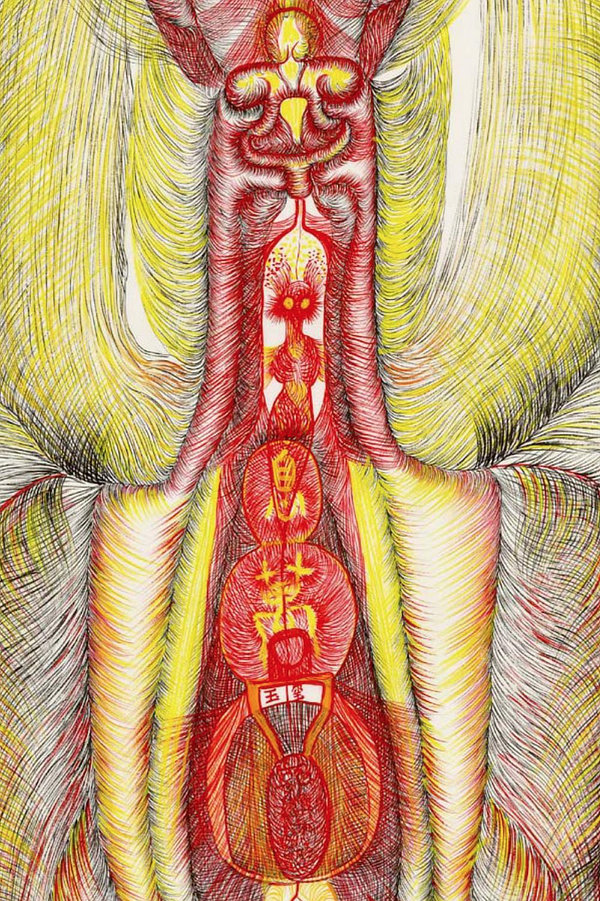
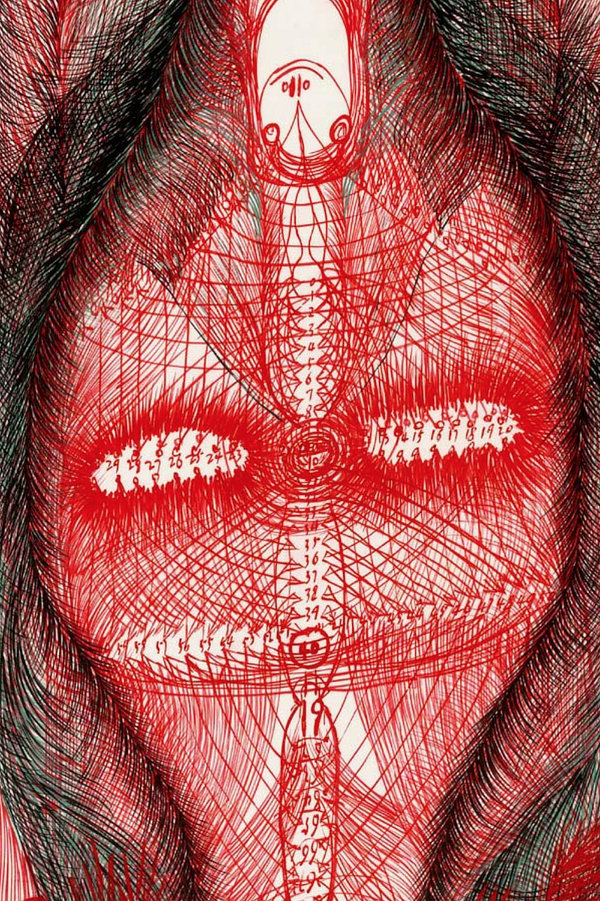 Left: Guo Fengyi, Level of Guo Fengy's Qigong Practice, 1992. Color ink on hanging rice-paper scroll. Courtesy of Long March Space.
Left: Guo Fengyi, Level of Guo Fengy's Qigong Practice, 1992. Color ink on hanging rice-paper scroll. Courtesy of Long March Space.
Right: Guo Fengyi, Numeric Code, 1992. Color ink on hanging rice-paper scroll. Courtesy of Long March Space.
The shamanic aspect of Guo Fengyi's work is reflected in her later works in a rich mythological cosmos of figures of animals and gods, mystical compositions and above all diagrams of cosmological, numerical-symbolic and paranormal topics. There are, for example, the strange creatures with heads at both ends, embedded in protective, fur-like clouds of rays, carved out of hair-fine strokes of colored ink that fill long hanging scrolls of paper. These are majestic formations of vertically meandering, elongated bodies in a sophisticated layering of countless brushstrokes placed side-by-side and on top of each other, creating a vibrant field of color with mysterious references.
Like all mediumistic artists, Guo rejected authorship of her works. She claimed that her works are messages that come from heaven. In the qigong state, she gained the ability to receive revelations.
The Drawing Center in New York is now bringing together numerous works by Guo Fengyi in an impressive exhibition that offers an inspiring insight into a singular artistic corpus.
Notes:
[1] Hans Körner: „Die Anfänge der spiritistischen Kunst – Victor Hugo, Victor Hennequin und Victorien Sardou.“ In: Botschaften aus dem Jenseits, Hans Körner, ed. (Studia humaniora. Düsseldorfer Studien zu Mittelalter und Renaissance Bd. 35), Düsseldorf 2002, pp. 157-196.
[2] On the history and development of Qigong research in China in connection with parapsychological concepts cf.: Elmar R. Gruber: Psychic Wars: Parapsychology in Espionage and Beyond. London: Blandford, 1999, pp. 121–126, 166–169.
[3] Elmar R. Gruber: Tranceformation: Schamanismus und die Auflösung der Ordnung. Basel: Sphinx, 2982. Elmar R. Gruber: "Outside and Inside the Paranormal." In: B. Shapin and L. Coly (eds.), Parapsychology's Second Century Proceedings of an International Conference, London, 1982. New York: Parapsychology Foundation, 1983, pp. 39-54.
[4] Lucienne Peiry: "Guo Fengyi e il valore terapeutico della pittura." Osservatorio Outsider Art 13, 2017, pp. 116-127.
[5] Thomas Heise: Qigong in der VR China: Entwicklung, Theorie und Praxis. Berlin: Verlag für Wissenschaft und Bildung, 1999.
All images in this article: Courtesy of Long March Space.
text © 2020 Elmar R. Gruber
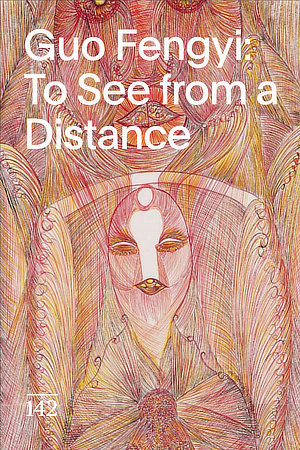 Guo Fengyi: To See from a Distance
Guo Fengyi: To See from a Distance
The Drawing Center
35 Wooster Street
New York, NY, 10013
February 20 – May 10, 2020
